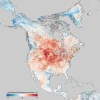Noctilucent clouds, a rare and captivating atmospheric phenomenon, have been fascinating skywatchers for centuries. These delicate, silvery-blue clouds, often described as “night-shining,” are typically visible only at latitudes between 45° and 80°.
They appear high in the sky on clear summer nights, shimmering faintly against the darkening horizon.
However, sightings of these clouds, once extremely uncommon, have become more frequent in recent decades, and new research suggests that space launches may be contributing to their increased occurrence.
Noctilucent clouds form in the mesosphere, about 50 miles (80 kilometers) above Earth’s surface.

They consist of thin sheets of ice crystals, which require specific conditions to develop: dust particles, moisture, and extremely cold temperatures.
Traditionally, these conditions have been rare, often triggered by events like explosive volcanic eruptions or meteor showers.
In the 19th century, noctilucent clouds were so infrequent that they were observed only once every few decades. Today, however, they can be seen several times each summer, with July being the peak month for sightings.
A study published in the journal *Earth and Space Science* has found a strong correlation between the frequency of noctilucent clouds and summer rocket launches.
Each launch releases large quantities of water vapor into the atmosphere. If the wind conditions are favorable, this water vapor can settle in the mesosphere, creating the perfect environment for these clouds to form. This study highlights the unintended consequences of human activity on atmospheric phenomena.
In addition to space launches, climate change is also thought to be influencing the increase in noctilucent clouds.
As global temperatures rise, the mesosphere becomes colder, enhancing the conditions necessary for these clouds to appear. As a result, noctilucent clouds are no longer a rare sight but a more frequent feature of summer nights.

